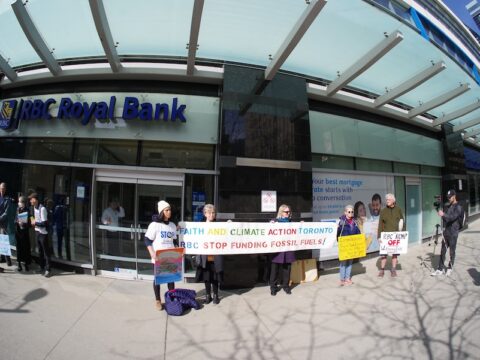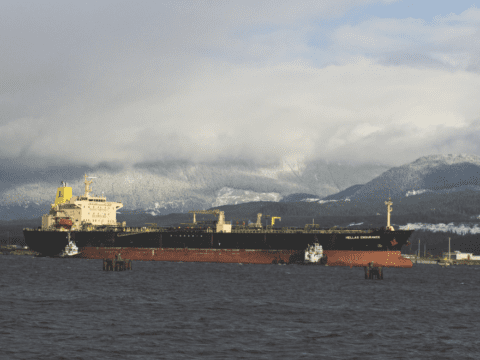The evening I arrived in Fort McMurray, Alta., I turned on the television in my hotel room and stumbled upon a CBC Fifth Estate documentary about green energy in Germany. An entire city has been transformed into the world’s biggest maker of photovoltaic cells, the panels that produce solar energy. This high-tech industry is growing so fast, it’s expected to surpass automobiles as a source of employment in Germany. The documentary showed how new technologies help farmers turn methane from manure into electricity and sell it to the grid, and how green energy is poised to supersede nuclear. Then came a short documentary about electric cars called Zero Emissions, No Noise.
From where I was sitting, it might as well have been a science fiction movie. The next morning, I was scheduled to board a small airplane and fly over the exact opposite of what I was watching from Germany: the Alberta oil sands. I was also about to discover how, as Canada gets ready to play host to the world’s biggest industrial project, hardly anybody is allowed to raise a discussion about it.
Centuries ago, Indigenous Peoples realized there was something exceptional about the bitumen-soaked soil along the banks of the Athabasca River in northeastern Alberta. But it was only in the 1960s that engineers considered it feasible to try to extract the petroleum. There were drawbacks: it was expensive to get at, far from markets and environmentally messy. It would have to be mined from open pits, and “cooking out” the oil would require vast quantities of water and natural gas. Open-pit mines would scar the landscape; the processing would produce an enormous amount of greenhouse gases; and the residual bitumen in tailings ponds would be toxic and potentially difficult to get rid of. For this extraction to be profitable, world-market oil needed to be at least US$80 a barrel. Still, with the encouragement of both the Alberta and Canadian governments, construction started in the mid-1970s. One thing the oil sands could produce from the very beginning was jobs. Workers flocked to Fort McMurray, first from all over Alberta, then from eastern Canada (mainly Newfoundland), then from around the world.
Thirty years later, the oil sands produce 750,000 barrels of crude per day — still not quite profitable, though they certainly were so briefly when oil prices spiked to US$147 in the summer of 2008. With the recession, and oil back down to US$40 earlier this year, investment in new construction was pulled back to less than half of what had been expected.
And yet, everybody believes that the moment oil sands proponents have been waiting for is nearly upon us. The reasons?: the rapid depletion of easier-to-get-at oil from cheaper and more conventional sources (seven of the world’s top 10 oil fields are past peak, and 400 conventional wells become extinct every day); the United States’ objective to wean itself from politically troublesome Middle East oil; and the burgeoning markets for oil in places like India and China.
Together, these forces are bringing us rapidly closer to what experts refer to as “peak oil,” the point at which we will have used up half of the Earth’s known supplies of oil and will face a future of increasing scarcity. Alberta oil sands and their potential 173 billion barrels of recoverable oil are poised to become a major supplier in the world market.
What is already on the ground north of Fort McMurray could increase sevenfold, and the global pressures are intense. The president of France’s Total Oil told the Globe and Mail in May: “We believe the oil sands are necessary to supply demand growth,” and stated that his company was prepared to invest $20 billion there over the next decade with the expectation of producing a quarter of a million barrels of oil per day by 2020.
Those who prophesize peak oil warn that the crisis about to overtake the planet is not only climate change due to the burning of fossil fuels, but the end of our easy access to those fossil fuels altogether. In other words, before climate change irretrievably alters our world, we might very well run out of the stuff that causes it. We’re probably not going to run out of oil completely, but we are fast reaching the point when the only oil left will be hard to get: deep under the sea, far below the arctic ice, laced into the tar sands of Alberta.
What will this do? Mainly, it will radically drive up the price of oil and thus the cost of living. As CIBC economist Jeff Rubin suggests in his book Why Your World Is About to Get a Whole Lot Smaller, all of us will have to radically alter the way we live. Oil (or more broadly, hydrocarbons) is central to almost everything in our modern lifestyle: transportation, heating and food. Agriculture itself is dependent on oil not only for transportation, but also for farm fuel, chemical fertilizers and pest controls. Furthermore, everything from plastic to synthetic fabric is made from oil.
As we approach this dramatic moment in history, all sides have become fixed in their positions. Governments see jobs and money; Prime Minister Stephen Harper famously bragged to the world that Canada would become an energy superpower. The global oil companies, preoccupied with securing their supply, are rapidly staking out leases and raising investment.
On the other side, environmentalists are calculating the costs to the landscape and the planet. Authors such as Andrew Nikiforuk (Tar Sands: Dirty Oil and the Future of a Continent) and Tony Clark (Tar Sands Showdown) have weighed in with warning-laden books. International publications such as the Manchester Guardian and National Geographic have followed suit. The polarization can make you dizzy. For every critical report from environmentalists, there’s a positive pronouncement from the industry-supported Oil Sands Developers Group.
AMONG THOSE TRYING TO OFFER a broader (or at least a different) perspective are church leaders. This past spring, representatives of Canada’s Anglican, Lutheran, Catholic, Christian Reform, Quaker, Mennonite, Presbyterian and United churches embarked on a fact-finding expedition organized by the inter-church organization Kairos, which has a mandate to promote ecological justice. Kairos executive director Mary Corkery explained that she first wanted to take the Canadian church delegation to the oil fields of Nigeria, but then decided “to start at home.” I joined them for an aerial survey of the oil sands and a visit to two affected communities: the First Nations reserves at Fort Chipewyan and the city of Fort McMurray.
Flying over the oil sands in a small plane is not for the faint of heart. Tilting at 45-degree angles, we looked down on something the scale of the Grand Canyon, yet all man-made — astonishing and appalling at the same time. Below us, under a brown haze of dust, the heavy soil covering an area that stretches 60 km in all directions was being methodically scooped out by giant shovels, then hauled away by equally gigantic trucks. The processing plants, situated along the Athabasca River, heat river water with natural gas to cook out the oil. The ratio of energy produced to energy consumed is 6 to 1, which compares poorly to conventional oil production, widely considered to be 100 to 1. Beyond the pits, wide swaths of land have been cleared of trees, ready for future exploitation. Behind the plants are tailings ponds where a flock of 500 ducks famously landed a year ago, much to their unhappiness (as well as that of Syncrude’s public relations manager).
OUR PLANE LANDS 200 km downstream at the historic fur trade community of Fort Chipewyan. For the next two days, the religious leaders are feted, toured and set upon by locals concerned about traditional lands, fishing economies spoiled by contaminants in the water and increased rates of human cancers — disputed elsewhere but vigorously argued here. “When we ask about these things, they call us crazy,” says Fort Chipewyan chief Allan Adam. The complaints hit their mark; Roman Catholic archbishop James Weisgerber promises “to go back home and raise some hell.”
The oil sands project, former United Church moderator Very Rev. Bill Phipps tells me, “crystallizes everything. It is about business arrangements; technologies; our relations with the rest of the world; relations with Aboriginal people; our responsibilities to the environment; and the implications of our lifestyle.” However, not everybody welcomed the religious leaders’ input. Prior to the trip, Phipps was interviewed on CBC radio. He explained that “this is a complicated project, and we need to struggle with it layer upon layer upon layer.” The response was decidedly defensive. The following morning, callers and bloggers asked questions like “What kind of experts are a bunch of church leaders?”
Other media quickly weighed in. National Post writer Colby Cosh penned a column demanding, “On what authority does a hand-picked gang of liberal Christian leaders descend on the oil sands to make a social and ethical audit of them?” Zeroing in on Phipps, he went ad hominem: “Phipps is nothing but a nice, democratic-socialist pagan fellow who once enjoyed important responsibilities as head of a big Canadian social organization — a sort of super-sized Elks Club or Kiwanis.” Cosh went on to describe the outing as “tar baiting.” The local Fort McMurray newspaper anticipated the visit with an editorial titled “No Oil Sermons Needed.”
A WITTICISM HAS IT that Fort McMurray, Alta., is Newfoundland’s third-largest city. With the arrival in the oil town of people from all over the world, that is changing. My taxi driver, Mohamed, is Somali-born. But the largest contingent of workers has always been Newfoundlanders. Ona Sunday afternoon, the Newfoundlanders Bar and Restaurant hosts a gaggle of middle-aged men exchanging gossip about who has recently died “back home.” My airplane seat mate from Toronto to Edmonton was a 50-year-old man named Lawrence who has spent the last 20 years as a pipefitter at the Syncrude plant. Lawrence never moved his family to Alberta and now, particularly after becoming a grandfather, misses them. Resettling would involve buying a house that, according to the real estate panels in the Peter Pond Mall, would cost at least $500,000. But to quit his job and return home would mean forgoing a six-figure paycheque. So Lawrence continues his travels back and forth.
Mohamed complains that men outnumber women in Fort McMurray, yet I sense there are many more families here now than when I last visited in the 1980s. Schools, churches and even a mosque have sprung up; jewelry and family clothing stores are prominent in the centre-of-town mall. Rev. Terry Shillington, who was minister at First United until last June, explains that the congregation has families whose history in the community predates the oil sands by several decades. But the sense of this being a one-industry boomtown is pervasive. “You have to know that things are more complicated than those with simple answers think,” Shillington warns me.
When the touring church leaders gather in the Catholic church to meet with townspeople, a woman named Erin Parent who has lived in Fort McMurray for 28 years and is married to an oil engineer asks them, “Are you just here to see the nasties? Our experience is that people come in to do a judgment on us. I’m not trusting you guys yet.” Rev. Susan Horton, the local Lutheran pastor whose husband is payroll administrator for PetroCanada, reiterates the fear of being judged. “We are tired of being a scapegoat,” she says.
United Church members Alistair and Alison MacKay arrived in Fort McMurray from the United Kingdom 25 years ago. Alistair is now a manager at Suncor. “I’m glad,” he says, “to have this delegation come. I’m not worried about a preconceived agenda. If you had a preconceived agenda, you would have just flown over and then made your pronouncement.” MacKay also offers his thoughts on peak oil: “There’ll always be a demand for oil for things like plastics, so this is a resource we need to steward. What we need to get away from is using it as a fuel.” Shillington sums up local attitudes: “The people here refuse to be the culprits in a conversation that includes us all.”
Even Indigenous communities have a complicated relationship to the oil sands. The two First Nation bands that make up Fort Chipewyan may take legal action to halt further oil leases on their traditional lands. But their Mikisew Group of Companies owns a hotel in Fort McMurray, a couple of energy services companies and the airline that flew us in on our junket. A substantial number of Fort Chipewyan people go work on the oil projects. Four hours in the other direction, 70 members of the Cree First Nation of Goodfish Lake are employed to do Syncrude’s laundry and mending.
IF THERE IS A CULPRIT that everybody — Fort McMurray townspeople, Indigenous Peoples, oil industry professionals and environmentalists — can agree on, it’s the government, both Alberta’s and Canada’s. Simon Dyer is a terrestrial ecologist working for the Pembina Institute, a Calgary-based think-tank for the environment.
“The oil sands are not on a sustainable trajectory,” he says. He blames a lack of regulations: weak provincial ones and almost non-existent federal ones. “It isn’t the job of the companies to protect the public interest. The government’s lack of regulations allow liquid tailings, the withdrawal of water from the [Athabasca] river at times of low flow, and the increase of carbon dioxide to increase greenhouse gases.”
The only possible explanation for the government’s laissez-faire approach is the fear that tougher regulations might frighten off the oil companies. But the companies claim they would obey stricter regulations. Tougher rules might make oil more expensive, but they would also promote conservation and a search for alternatives. The oil sands won’t disappear, but many believe development ought to proceed more slowly. Former Alberta premier Peter Lougheed famously proposed undertaking only one project at a time, which would, among other things, “give time for technology, from an environmental point of view, to catch up.”
This plan seems unlikely, though it might get a shove if U.S. President Obama’s administration labels the oil sands “dirty” in its impending Clean Energy and Security Act. “The Alberta government,” says Dyer, “seeks to maximize development without in the least maximizing benefits to Albertans. That’s the wrong sort of metric. From the federal government, there is a complete absence of oversight and responsibility.”
As Bill Phipps put it, the oil sands embody all manner of issues about how we approach our world. We don’t know how things will look a generation from now. Maybe green technologies like those in Germany will have transformed everything. Perhaps using hydrocarbons for fuel will seem as quaint as wood or whale oil looks to us now. The future developments could happen quickly and in ways that surprise us. The big problem, however, the one we are all invested in answering and the one that ought to spur rather than squelch discussion and debate is this: how do we behave in the meantime?
***
This story first appeared in The United Church Observer’s September 2009 issue with the title “Black gold or green disaster?”















